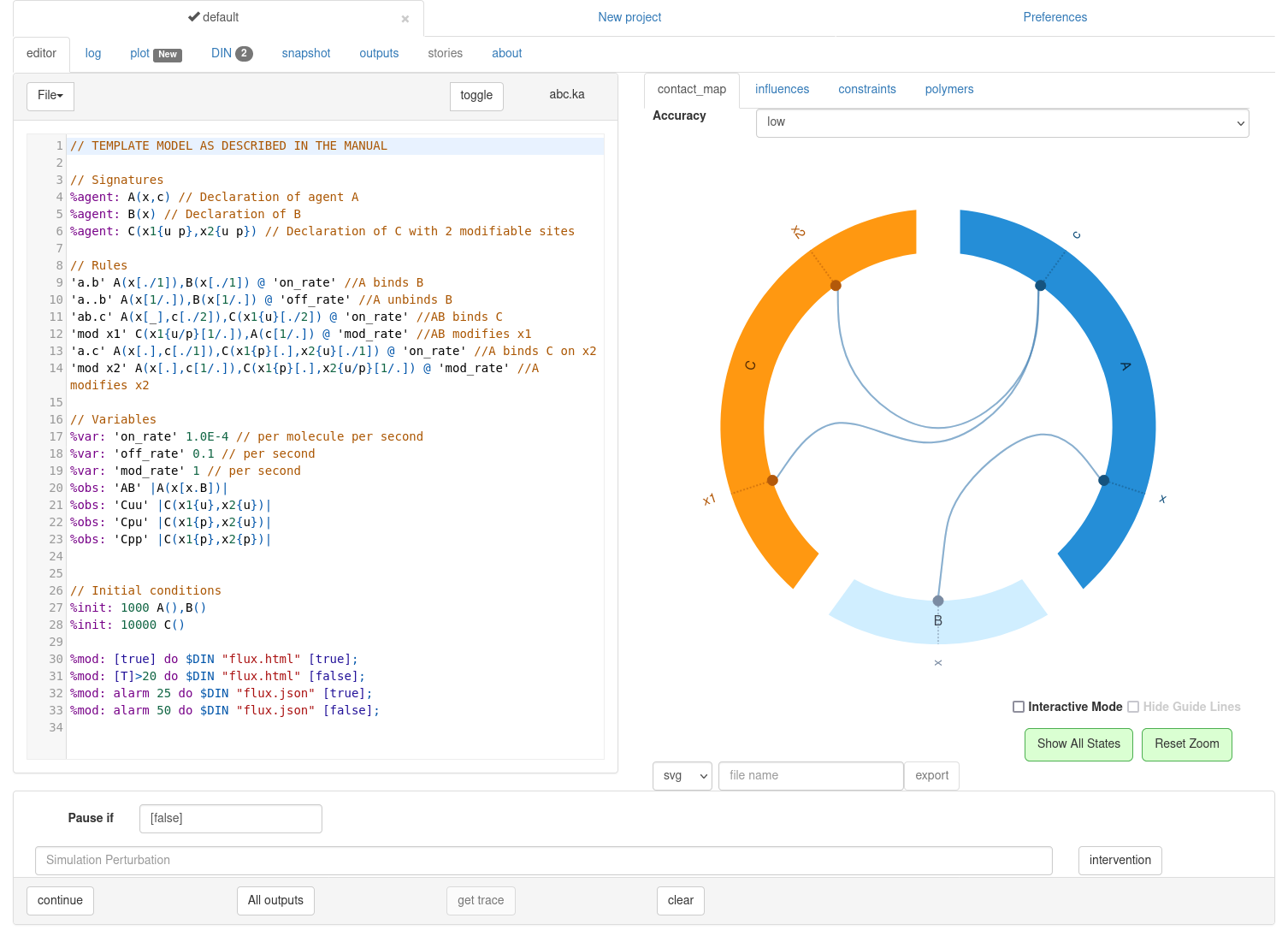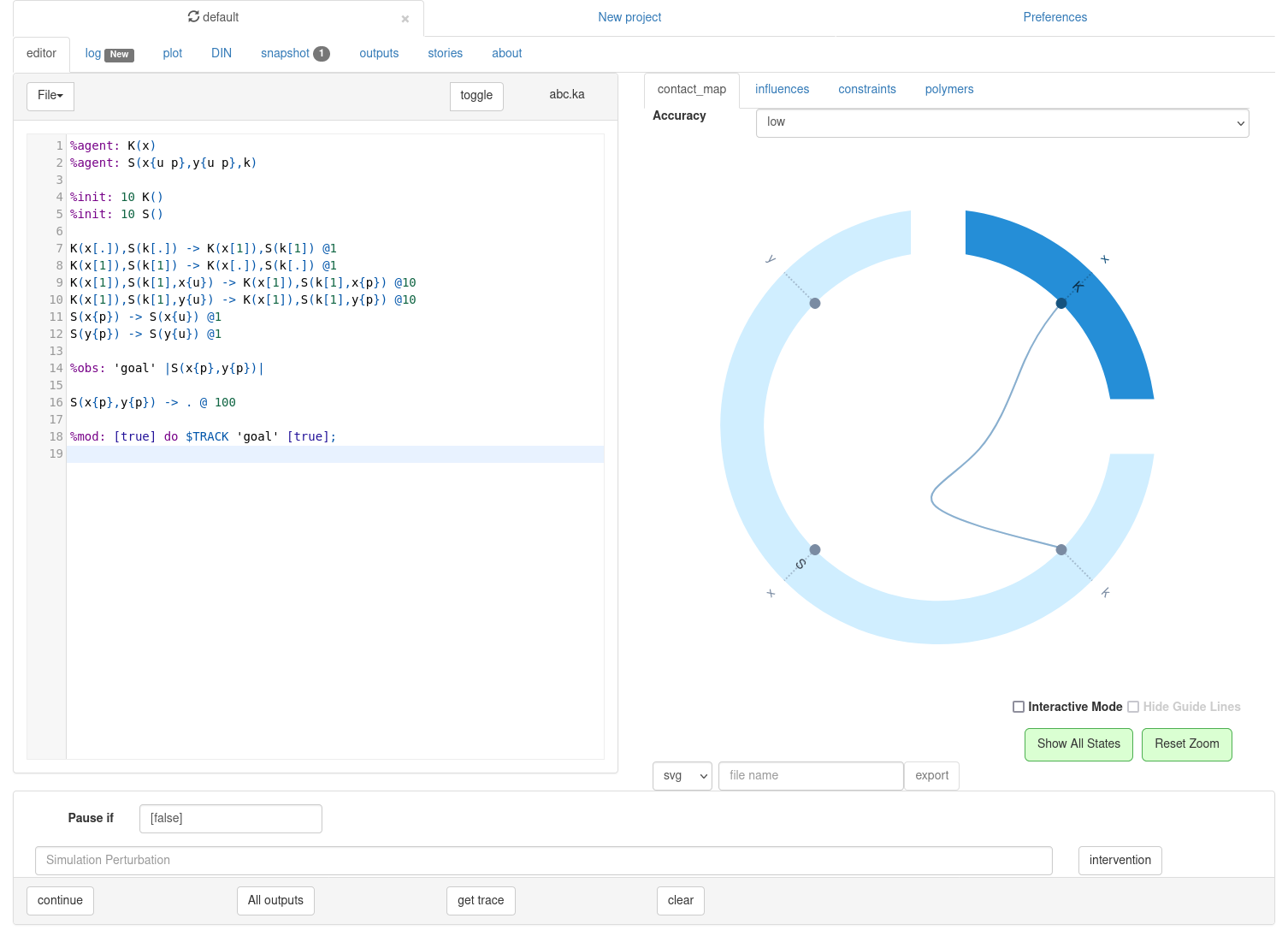KaSim is a stochastic simulator for rule-based models written in Kappa. KaSa is a static analyser for Kappa models.
Kappy is a python library to launch and analyse runs and outputs of Kappa models.
If you are new to Kappa, the easiest way to start experimenting with it is using the webapp.
It's available directly in your browser, or for more performance as a downloadable electron app, available for MacOS, Windows and Linux.
Kappa tools are also available as Command-Line Interface programs, which you can either build following the instructions below,
or find the binaries included with the electron app in subdir resources/bin.
If you would like to use python to interact with the Kappa tools, the kappy lib is where to look. Here's an example of its usage with ipython
In [2]: import kappy
In [3]: model_text = "%agent: A(x)\nA(x[.]), A(x[.]) <-> A(x[1]), A(x[1]) @ 1e-2,1\n%plot: |A(x[.])|\n%init: 100 A()"
In [4]: kappa_client = kappy.KappaStd()
In [5]: kappa_client.add_model_string(model_text)
Out[5]: [...]
In [6]: kappa_client.project_parse()
Out[6]: [...]
In [7]: kappa_client.simulation_start(kappy.SimulationParameter(.1,"[T] > 10"))
Out[7]: {'simulation_artifact_simulation_seed': 297327779}
In [8]: kappa_client.wait_for_simulation_stop()
Out[8]: [...]
In [9]: kappa_client.simulation_plot()
Out[9]:
[6.7, 48.0],
[...]
[0.4, 60.0],
[0.3, 50.0],
[0.2, 64.0],
[0.1, 62.0],
[0.0, 100.0]]}See the install instructions to start using kappy.
See documentation page on kappalanguage.org.
Kappy API documentation is online.
The latex sources of the "older" reference manual (and KaSa one) are
available in the man/ directory. To compile the manuel, in addition of
a decent LaTeX distribution you need
gnuplot and
graphviz to generate images (make sure
that dot is in the PATH of your OS). To generate the pdf of the
manual type
make doc
Released versions come with binaries for MacOS, Windows and Debian derivatives (as Ubuntu). Nightly builds of the master branch are built for these platforms by the continuous integration tools.
If you want or need your own build,
- Install opam (the OCaml
package manager) and initialize it (by issuing
opam init) - In the source directory, install all the dependencies by
opam install --deps-only pinned_libs/defaultif your OS is OSX or linux, oropam install --deps-only pinned_libs/windowsif your OS is Windows. dune build
You can be more fine grained if you only need the command-line tools
(and therefore could install less dependencies) by doing opam install --deps-only kappa-binaries followed by make all
If nothing worked for you so far. Well, you're pretty much on your
own... Kappa tools depend upon the OCaml native compiler version
4.05.0 or above as well as dune, findlib, Lwt (>= 2.6.0), Re,
Fmt, Logs and Yojson libraries. Find any way to install them and
you'll be only a make all away from getting Kappa binaries...
You should be able to pip install kappy.
- Under MacOS and linux (and if you're not using a python version so cutting edge that we haven't notice its release yet), wheels that contain the core binaries should be available.
- For other platforms/python versions, you need to get kappa agents by
yourself thanks to the opam package manager by
opam install kappa-binaries kappa-agents(or use an externaly hosted REST API) - In order to develop in kappy and run all its tests, you need to follow the "get your own build section" above as well as install requests (and future).
In order to run a simulation for 100 time units printing observables values every 0.5 time unit, type
bin/KaSim kappa_file_1 ... kappa_file_n -l 100 -p 0.5 -o data_file
This will produce a data file of 200 point containing the trajectory that was produced during the simulation.
Type:
bin/KaSim --help
for a complete list of options.
Do:
import kappy
client = kappy.KappaRest("http\:https://url_of/the_server","project_name")to get a kappa client that uses the REST API hosted by http:https://url_of/the_server and deals with project project_name.
or do:
import kappy
client = kappy.KappaStd()to get a kappa client that uses a kappa agent installed locally. Add a
string argument specifing the path/to/KaSimAgent to use a specific agent.
A minimal example of usage is:
model = "\
%agent: A(x[x.A]) \
%var: n_0 100 \
%var: k_on 1e-2 \
'rule' A(x[.]), A(x[.]) <-> A(x[1]), A(x[1]) @ k_on, 1 \
%plot: |A(x[.])| \
%init: n_0 A()"
client.add_model_string(model)
client.project_parse()
sim_params = kappy.SimulationParameter(pause_condition="[T] > 100",plot_period=1)
client.simulation_start(sim_params)
client.wait_for_simulation_stop()
results = client.simulation_plot()
client.simulation_delete()
# Rerun with some overwritten values for algebraic variables
client.project_parse(k_on=5e-2,n_0=500)
client.simulation_start(sim_params)
client.wait_for_simulation_stop()
results' = client.simulation_plot()
client.shutdown()Launch the core/integration tests by make check.
Regenerate the reference files if you've changed something in the
outputs by make build-tests
Launch python tests by nosetests (after having followed the "Get
your own build" section).




